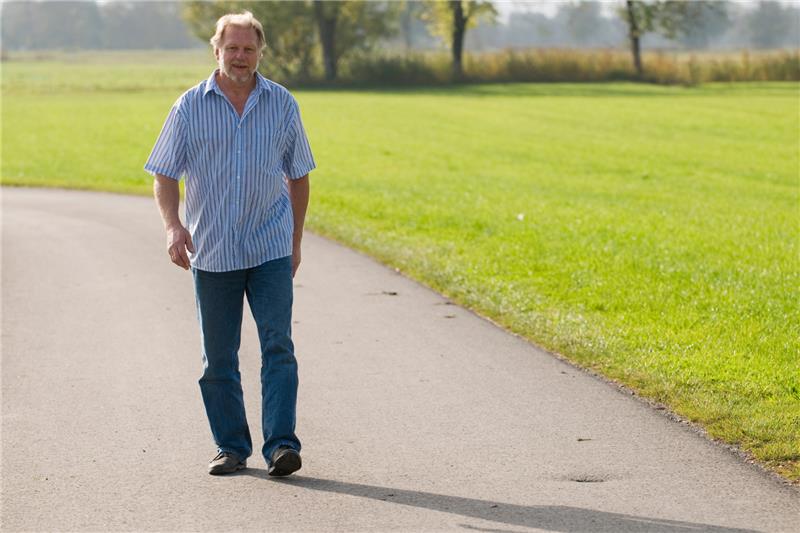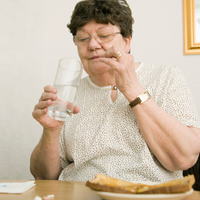The lack of dopamine levels in the brain means people can have difficulties in controlling their movements and moving freely. Movement slows, muscles stiffen, and posture can change. These changes can lead to challenges with walking, increasing the risk of falling and freezing.

Walking (Gait)
Gait is used to describe how a person walks and it is often impaired in people living with Parkinson’s.
The most common changes include, slowed movement, small steps or shuffling, little or no swing of one or both arms, and a tendency to lean forward when walking.
It’s also common for people living with Parkinson’s to become easily tired during walking, even after short distances. This is likely to become more prominent as Parkinson’s progresses. Changes to walking can be related to the medication cycle, e.g. because of the ‘on/off’ cycles of Parkinson’s medications.
Tips for walking safely
- Always take medications on time
- Undertake regular exercise to help with balance and leg strength
- Wear supportive footwear
- Walk to a rhythm (listening to a beat or music can help)
- Focus on taking long strides
Falling
Gait impairment can make people living with Parkinson’s more likely to fall. Other causes of falls include reduced blood pressure and environmental hazards, both outside and in the home.
While falls can occur at any stage of Parkinson’s, they are more likely to happen during the later stages of the disease. Falling is particularly hazardous because of the risk of serious injury and are a common cause of hospital admission for people living with Parkinson’s.
If you’ve had a fall recently, advise your GP and neurologist, particularly if falls are becoming more frequent. Adjusting medications can prove helpful in some situations.
Tips to reduce the risk of falls at home
- Remove hazards in your home, such as rugs and furniture that obstruct walkways
- Ensure you have good overhead lighting, particularly at steps
- Install handrails at steps and grab rails in bathrooms
- Apply strips of tape to the floor in areas where freezing of gait occurs
- Purchase a pendant alarm system to alert others if a fall occurs
Freezing
Freezing is when a person stops suddenly while trying to move and the movement becomes frozen.
Freezing typically, occurs in specific situations, such as when starting to walk, stepping through a doorway, attempting to turn a corner, or approaching a chair.
People living with Parkinson’s may also experience episodes of freezing during other repetitive activities, such as brushing their teeth or writing. Freezing can also affect upper limbs and speech.
Freezing is normally only temporary, however is hazardous as it increases the risk of falling during walking and moving. Freezing is one of the movement symptoms that cannot be fully explained. Freezing is more common when completing complex tasks or multi-tasking becomes more difficult, suggesting a link between cognitive change and movement may contribute to freezing.
Tips to avoid freezing episodes
- Prompt yourself by saying aloud ‘left, right, left, right’ OR ‘one, two, one, two’ OR ‘one, two, three, step’
- Stand still and start swinging your arms
- Start shifting your weight from one foot to the other foot
- Visualise an imaginary line to step over
- Identify visual prompts such as lines in the pavement to maintain bigger steps.
Tips to overcome freezing episodes
- Always take your medications on time
- Walk to a rhythm (listening to a beat or music can help)
- Avoid distractions when walking so you can focus on long steps
Support for you
If you are experiencing mobility difficulties or freezing, you should consult with your GP about building a team of health specialists to support you such as occupational therapist or a physiotherapist. You might also speak to your GP about creating a chronic disease management plan, which will allow you a limited number of Medicare rebated visits to allied healthcare professionals.
For further information on falls prevention, Fight Parkinson’s offers a free course in Fight Parkinson’s Community Learning Hub. The course equips you with practical tools and strategies to help prevent falls. Learn to identify risk factors in your environment, discover effective preventive measures, and build confidence in managing unexpected situations.
Like all Fight Parkinson’s Community Learning Hub courses, this course is completely free and available to you whenever you need it, no matter where you are.



